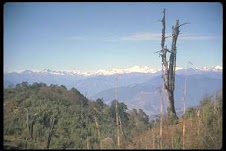EASTERN BHUTAN This region comprises Mongar, Lhuentse, Trashigang and Trashi Yangste. Passes crossed are Rodang La and Narphung La both at much lower altitudes than passes in Western and Central. The forests dissipate and the altitude is lower. The warmer climate is suitable for growing corn, rice, wheat, potatoes and surprisingly lemon grass. Eastern Bhutan is known for its stunning hand-loomed textiles and the weavers are all masters of the "supplementary weft-weave" technique. Eastern Bhutan is the least traveled area of the country. Below described the main areas of Eastern Bhutan. |
MONGAR
Altitude: 1,700m / 5,580ft.
The differences between Eastern and Western Bhutan are far greater than the high pass that separates them. Perhaps like the Scots and the English, there are subtle but marked differences. History has played a significant role with the kingdom only being unified with the east at the end of the last century. Prior to that many wars separated each side.
The eastern dialect is so different from the western dialect that the two groups find it difficult to understand each other. Thrumsing La and a seven-hour drive separates Ura from Mongar in the East. The journey is one of the most beautiful in all the Himalayas. Rising out of Ura, the highway climbs steeply to the highest pass (3,800 meters, 12,800 ft.) along the West-East highway at Thrumsing La (during the Winter the pass can be closed for several days after snowfalls) where the mountains of east Bhutan can be seen during clear weather.
The descent from Thrumsing La to Lingmithang is astonishing for several reasons. The road drops from 3,800 meters to a mere 650 meters in only a few hours passing from pine forest through semi-tropical forest and orange groves. Carved out of the side of the mountain, here the road follows a sheer cliff face 1000 feet above the valley floor. Arriving at Mongar marks the beginning of your eastern Bhutan experience. Towns in eastern Bhutan are built on the sides of the hills which contrasts to valley floor settlements in the west. Mongar Dzong was built in 1953 on the orders of the Third King, Jigme Dorje Wangchuck. The Royal Guesthouse is located near the dzong enjoying a pleasant view from the garden over Mongar Valley. Some of the finest weaving villages in Bhutan are found in the Mongar area.
TRASHIGANG
Altitude: 3,773m / 12,375ft.
Trashigang is the eastern-most point on the highway. Eastern residents use Trashigang to trade and the town itself is usually a hive of activity, especially around the bus station where buses are frequently leaving for Thimphu and Paro in the west and Samdrup Jongkhar and India, only a few hours to the southeast. A short distance is Radhi considered one of Bhutan's most renowned weaver villages. Trashigang is also a melting pot of hill tribe people who come to the town to trade. The villagers of the remote Merak and Sakteng areas come to Trashigang to trade yak's butter for the provisions that they need in the mountains. Merak and Sakteng are located about 50 miles east of Trashigang close to the border with India's Arunachal Pradesh.
Trashigang Dzong sits on a jagged piece of land jutting out from the town and is the first landmark that can be seen from the road winding up to Trashigang. The Dzong was built in 1659 and commands a spectacular view over the valley for which it is the administrative center. The Dzong is significant for the fact that it only has one courtyard.
TRASHI YANGTSE
Altitude: 1,850m / 6,070ft.
On the drive to Trashi Yangtse you pass the small town of Duxsum located on the Drangme Chhu and its tributary. It is a few kilometers past Gom Kora. A large boulder sits in the garden of Gom Kora (Gomphu Kora) Temple and it is said that if anyone can climb below the rock and emerge from its summit, he will be forgiven of his sins. Duxsum is a small weaver's town where you can find a fair amount of weavers producing some very nice work. The landmark of the town is a original iron chain suspension bridge built by Thangtong Gyalpo or Lama Hazampa (Lama Iron-bridge) in the 1600's. Duxsum is the main supply town for all the high mountain villages that surround it.
Trashi Yangtse is a small town and a lovely place from where the visitor can launch a hike into the surrounding countryside. Chorten Kora is one of the only two such stupas in Bhutan with styles similar to those found in Nepal and is host to a great festival every March which attracts all of eastern Bhutan's residents. The Chorten is entirely whitewashed and ideally situated next to a running brook. Trashi Yangste is also famous for its hand made wooden bowls and cups used all over the country. The finest are made from rhododendron burl.
SAMDRUP JONGKHAR
The road from Trashigang to Samdrup Jongkhar was completed in the early 1960s and enables the eastern parts of the kingdom to access and benefit from trade with the south as well as across the border into India. It is possible to drive from Samdrup Jongkhar to Phuentsholing, the eastern border town, via Assam and West Bengal of India.
From Trashigang the road descends through thick jungle before arriving at the border town of Samdrup Jongkhar. The town is no more than a frontier post with a couple of hotels and restaurants. Visitors can exit Bhutan from Samdrup Jongkhar, instead to driving back all the way back to Paro or Phuentsholing. Guwahati airport in India is located about 100 km from the border and from there there are daily flights to Calcutta and Delhi.


No comments:
Post a Comment